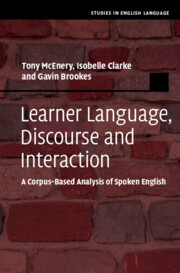Refine search
Actions for selected content:
73 results
The power of social talk: A longitudinal network analysis of conversations in fostering interdisciplinary collaboration
-
- Journal:
- Journal of Clinical and Translational Science / Volume 9 / Issue 1 / 2025
- Published online by Cambridge University Press:
- 13 August 2025, e194
-
- Article
-
- You have access
- Open access
- HTML
- Export citation
How (not) to advance Global IR: a rejoinder
-
- Journal:
- International Theory / Volume 17 / Issue 2 / July 2025
- Published online by Cambridge University Press:
- 31 July 2025, pp. 268-286
-
- Article
-
- You have access
- Open access
- HTML
- Export citation
Chapter 7 - Vulnerability, Dialogue, and the Limits of Autonomy
- from Part IV - The Limits of Autonomy and Self-Rule
-
-
- Book:
- Platonic Autonomy
- Published online:
- 07 August 2025
- Print publication:
- 31 July 2025, pp 149-168
-
- Chapter
- Export citation
Temporal relationships between speech and hand gestures in the vicinity of potential turn boundaries in German and Swedish conversation
-
- Journal:
- Language and Cognition / Volume 17 / 2025
- Published online by Cambridge University Press:
- 21 July 2025, e57
-
- Article
-
- You have access
- Open access
- HTML
- Export citation
Revising and extending Gricean maxims: The TRICS-Principles
-
- Journal:
- Journal of Linguistics , First View
- Published online by Cambridge University Press:
- 04 July 2025, pp. 1-28
-
- Article
-
- You have access
- Open access
- HTML
- Export citation
Chapter Ten - Language as a Whole-Brain Enterprise
-
- Book:
- The Neuroscience of Language
- Published online:
- 17 April 2025
- Print publication:
- 10 April 2025, pp 216-237
-
- Chapter
- Export citation
3 - Having the Drug Conversation with Your Child
-
- Book:
- How to Talk to Your Child About Drugs
- Published online:
- 13 February 2025
- Print publication:
- 06 March 2025, pp 36-55
-
- Chapter
-
- You have access
- HTML
- Export citation
Shifting toward progressive and balanced interaction: A longitudinal corpus study of children’s responses to Who-questions in Japanese
-
- Journal:
- Journal of Child Language , First View
- Published online by Cambridge University Press:
- 26 February 2025, pp. 1-27
-
- Article
-
- You have access
- Open access
- HTML
- Export citation
Chapter 5 - The ‘High Victorian’
-
-
- Book:
- Nineteenth-Century Literature in Transition: The 1870s
- Published online:
- 30 January 2025
- Print publication:
- 06 February 2025, pp 107-126
-
- Chapter
- Export citation
Chapter 2 - The Psychiatric Interview
-
-
- Book:
- Fundamentals of Clinical Psychiatry
- Published online:
- 02 January 2025
- Print publication:
- 16 January 2025, pp 3-8
-
- Chapter
- Export citation

Learner Language, Discourse and Interaction
- A Corpus-Based Analysis of Spoken English
-
- Published online:
- 09 January 2025
- Print publication:
- 23 January 2025
-
- Book
-
- You have access
- Open access
- Export citation
1 - Methods in Conversation Analysis
- from Part I - Introduction
-
-
- Book:
- The Cambridge Handbook of Methods in Conversation Analysis
- Published online:
- 06 December 2024
- Print publication:
- 05 December 2024, pp 3-48
-
- Chapter
- Export citation
13 - Using Digital Communication Support in Interaction Involving People with Dementia
- from Part 5 - Communicative Challenges in Everyday Social Life
-
-
- Book:
- Dementia and Language
- Published online:
- 21 November 2024
- Print publication:
- 28 November 2024, pp 292-315
-
- Chapter
- Export citation
Chapter 8 - The Club
- from Part II - Social, Cultural, and Intellectual Contexts
-
-
- Book:
- Oliver Goldsmith in Context
- Published online:
- 28 November 2024
- Print publication:
- 07 November 2024, pp 64-71
-
- Chapter
- Export citation
4 - Incoherence Brought to Order: Empiricism and the Essay
- from Part I - Forming the British Essay
-
-
- Book:
- The Cambridge History of the British Essay
- Published online:
- 31 October 2024
- Print publication:
- 04 July 2024, pp 48-62
-
- Chapter
- Export citation
19 - The Urban Familiar Essay of the Romantic Era
- from Part II - The Great Age of the British Essay
-
-
- Book:
- The Cambridge History of the British Essay
- Published online:
- 31 October 2024
- Print publication:
- 04 July 2024, pp 275-288
-
- Chapter
- Export citation
4 - A Mixed Methods Study
-
- Book:
- Emoji in Higher Education
- Published online:
- 30 May 2024
- Print publication:
- 06 June 2024, pp 83-111
-
- Chapter
- Export citation
A longitudinal study of conversational remembering in WhatsApp group messages before, during, and after COVID-19 lockdown
- Part of
-
- Journal:
- Memory, Mind & Media / Volume 2 / 2023
- Published online by Cambridge University Press:
- 30 November 2023, e5
-
- Article
-
- You have access
- Open access
- HTML
- Export citation
17 - The Voices of the People
- from Part III
-
-
- Book:
- When the People Rule
- Published online:
- 23 November 2023
- Print publication:
- 09 November 2023, pp 304-319
-
- Chapter
-
- You have access
- Open access
- HTML
- Export citation
Chapter 6 - Conversational Reason
- from Part II - Public and Beyond
-
-
- Book:
- Beyond the Analogical Imagination
- Published online:
- 28 September 2023
- Print publication:
- 12 October 2023, pp 130-152
-
- Chapter
- Export citation
